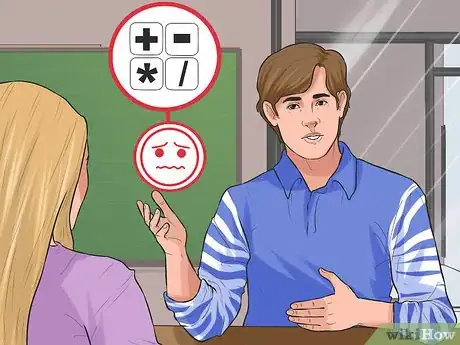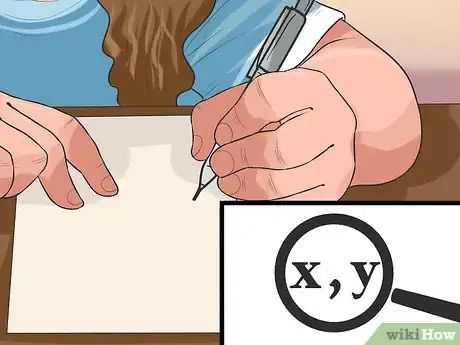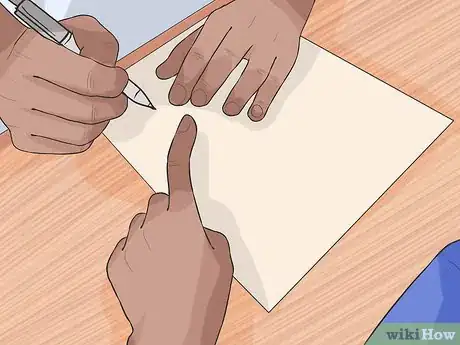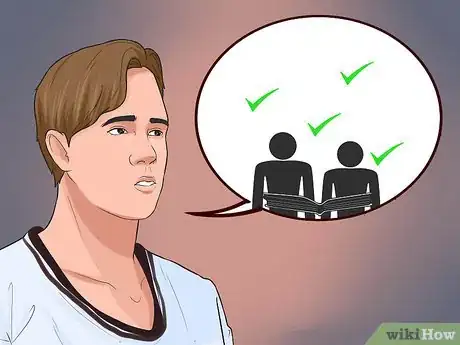This article was co-authored by Soren Rosier, PhD. Soren Rosier is a PhD candidate at Stanford's Graduate School of Education. He studies how children teach each other and how to train effective peer teachers. Before beginning his PhD, he was a middle school teacher in Oakland, California, and a researcher at SRI International. He received his undergraduate degree from Harvard University in 2010.
wikiHow marks an article as reader-approved once it receives enough positive feedback. In this case, 100% of readers who voted found the article helpful, earning it our reader-approved status.
This article has been viewed 149,550 times.
For many people mathematics is one of the most challenging subjects in school. Students that struggle find it helpful to get personalized one-on-one tutoring. In order to be a good mathematics tutor, you need to be patient and have a strong knowledge of the concepts that the student is struggling with. With some guided problem-solving and encouragement, your tutees will be succeeding at math in no time.
Steps
Teaching Your Students
-
1Know the material. If you know algebra really well, but are not as strong in calculus, only tutor algebra. Your students are learning from you and they can’t do that if you don’t know the material inside and out.[1] You also want to make sure you know the math standards that your student is expected to be proficient in.
- If you can’t solve all of the problems your student presents you, you shouldn’t be tutoring the subject.
- Review the material you will be teaching before you meet with your student.
- If you’re unsure about something, don’t give your student the wrong information. Look up the right answer later and discuss that concept at the next session.
-
2Relate math skills to everyday life. Many students struggle with math because they don’t understand the practical applications of it. If you can put the material in the context of their lives, they are more likely to understand and learn it.
- Ask your student about some of their favorite hobbies and try to incorporate those in your lessons.
- If you’re tutoring statistics and they like baseball, use baseball stats to help them learn.
Advertisement -
3Remind the student that they are intelligent. Making mistakes is a part of learning, and even the best mathematicians still make mistakes sometimes. Making mistakes does not mean that the student is stupid or that they "suck at math". For younger students, it can be especially important to keep up their confidence.
- Highlight the parts of the problem the student got right while correcting the errors to understand why it was wrong.
- Use phrases that emphasize the content they got right, such as “You did this part of the problem really well” and “The way you’re thinking about this is really smart.”
-
4Encourage questions. Asking questions is essential to success in math. Guide your student’s learning by asking them pointed questions that will help them get to the right answer instead of just telling them. Questions also help engage the student in the learning process.
- Make your tutor sessions a safe space where there are no stupid questions. If the student is confused about anything, they need to clarify that before they can move on to other concepts.
- Some good questions to ask your students, “Does the solution make sense?”, “What exactly is the problem asking for?”, and “What techniques do you know that could help you solve the problem?”
-
5Talk about math anxiety. Some of your students may have actual anxiety when trying to deal with math. Talk to your student about this and refer them to a counselor if you think the math anxiety is particularly serious. If you think your tutee is in a course that is too advanced for them, discuss the possibility of moving to a course on their level.[2]
- Avoid using phrases like “this problem is easy” as this can intimidate a student who doesn’t think it’s easy at all.
- Ask your student some of these questions to determine if they have math anxiety: Do you feel helpless when working on math or taking a quiz/test? Do you think you’re the only one that doesn’t understand math and everyone else is smarter than you are? Do you second guess everything you do, hoping others will do the work for you?
-
6Provide positive feedback. When they solve a problem all on their own, note that they now understand the material and congratulate them on this accomplishment. This encouragement will strengthen their confidence in solving future problems.[3]
- Frequent feedback helps the student know what they understand and what concepts they need to work on.
- Encouragement is particularly helpful for students who have math anxiety.
Working Through Problems
-
1Choose a specific problem to work through. Usually this will be a problem from the student's homework, textbook, or class. You should choose the easiest problem the student has difficulty solving. Work multiple examples of the same concept. If a student is struggling with math, they are likely not going to understand a concept by doing one problem. Succeeding in math is about repetition and practice.
- Ask the student if they have any problems they specifically want to work through before beginning.
- Doing multiple examples allows students to make connections and understand the similarities between the examples, gaining a firm understanding of the concept.
-
2Ask the student to attempt the problem. As they work through the problem, have them explain to you both what they do in each step and why. This will help them understand what they are doing and help you determine where they are going wrong in the solving.
- If they get stuck, ask questions to help get them on the right track: What techniques do you know that might help you solve this? Is there anything about this problem that is similar to another problem you know how to solve?
- Make sure they write down every step of the process to determine where things went wrong if the answer is incorrect.
-
3Correct any errors that are made. Often the student cannot find the correct solution because they made an error while solving the problem. If so, correct the error for them and ask them why they think it’s wrong.
- If they can’t figure it out, tell them why it’s wrong and offer suggestions on how to avoid making that error in the future.
-
4Guide the student through the problem. When the student asks "What do I do next?," do not show them how to solve the problem, instead show them how you would perform the next step. Try to avoid solving the problem for them, but show them the concept.[4]
- For example: If the student has come to the sum of two unlike fractions, show them how to add two unlike fractions using variables or numerals as appropriate to their level of mathematics.
-
5Ask the student to explain the problem again. Now that you have corrected their errors and guided them in the right direction, let the student attempt to progress through the problem once more. Ask them to explain the problem to make sure they truly understand the material and are not just repeating what you said.[5]
- Avoid asking questions such as “Do you understand?” or “Does that make sense?”
EXPERT TIPSoren Rosier is a PhD candidate at Stanford's Graduate School of Education. He studies how children teach each other and how to train effective peer teachers. Before beginning his PhD, he was a middle school teacher in Oakland, California, and a researcher at SRI International. He received his undergraduate degree from Harvard University in 2010.PhD in Education Candidate, Stanford University
 Soren Rosier, PhD
Soren Rosier, PhD
PhD in Education Candidate, Stanford UniversityAvoid these common tutoring mistakes. Soren Rosier, a PhD candidate and former teacher, says: "There are a few common pitfalls that people fall into when they're trying to teach other people. Many people explain too much, for instance, instead of letting the person they're helping do most of the talking. Also, using questions can be very helpful, but not if you're asking a lot of low-level questions to push the person in the direction of the right answer."
-
6Recognize that there is more than one way to solve a problem. Your student may approach a problem differently or may benefit from you explaining the concept in a different way. Make sure your tutee knows that it’s okay to solve the problem in the way that makes the most sense to them.
- Sometimes, kids can get caught up in the fact that the method you are teaching is not the way the teacher taught it. Let them know that it’s okay as long as they understand the fundamental concept.
-
7Repeat this process with similar problems. Correct errors and guide your student through the problem until they obtain the correct solution. Then choose a new problem that is similar to the first and do it all over again. Reinforce the correct procedures until the student can do that type of problem without help or errors.[6]
- Go through this whole process again with a new type of problem.
Acting Professionally
-
1Keep good records. If you have multiple tutees, you want to make sure you don’t lose track of any of them. Keep a binder or notebook where you track each student and the progress they have made. Use these records to help you plan your next session together. Review what was taught the week before and decide what new material to cover.
- Make a note after each session about concepts that you taught and what the student needs more work on.
-
2Foster a good tutoring environment. A good tutoring environment is not just the location where you tutor. You must let the student know that tutoring sessions are a safe space where they can ask any and all questions without feeling stupid. Be empathetic toward your student and the struggles they face with the material.[7]
- Integrate humor into a session to help the student feel relaxed.
- Choose a quiet space where you will be uninterrupted or distracted for the entire session.
-
3Communicate with your clients. A good tutor knows their client and understands their needs. If you are trying to teach them things they already know or things that are way beyond their knowledge, the tutoring isn’t going to help them. Talk to them about what they want to get out of the tutoring sessions and how you can help them.
- Schedule each appointment at least a week in advance and confirm these tutoring sessions the day before.
- Be flexible with the material. If you scheduled certain material, but your client wants to work on something else, listen to them. Do not force your agenda on them because that’s what you planned for the day.
-
4Set boundaries. Before you begin tutoring a student, discuss with them your boundaries. Let them know about your schedule and how often you are available. Make your own judgment call about whether or not your students can call/text/Facebook you outside of tutoring sessions.
- During tutoring sessions, all distractions such as phones/tablets/computers should be turned off and put away.
- Tutors and tutees should both abide by a code of ethics.[8]
-
5Seek out new clients. When you are first starting, finding clients can be difficult. Posting fliers around university campuses can be a good way to start. You can also work directly with a tutoring center and have them find clients for you.[9]
- Use the network of people you know to get the word out. Ask your friends and family to let their friends and family know that you are looking to tutor willing students.
- Use the internet to find new clients. Setup a professional internet page and include it on all of your written materials.
Community Q&A
-
QuestionWhat should I do if I'm tutoring a child who is going into 4th grade in mathematics?
 Community AnswerMost likely, the student will be getting an introduction to fractions, decimals, and percentages. Study up on those subjects. If you can find some ways to make it a little more fun with games/activities, that would probably help as well.
Community AnswerMost likely, the student will be getting an introduction to fractions, decimals, and percentages. Study up on those subjects. If you can find some ways to make it a little more fun with games/activities, that would probably help as well. -
QuestionWhat about online tutoring?
 Community AnswerOnline tutoring can be excellent for both the tutors and students, especially if the student lives in an area where in-person tutors are hard to come by. However, there are some factors to consider when deciding whether to tutor online. For example, is the tutoring website suitable for the subject? With mathematics especially, you'll need an environment that can handle formulas and equations with ease. You should also consider possible distractions (for both you and the student), along with the possibility of your internet going out and disrupting a tutoring session.
Community AnswerOnline tutoring can be excellent for both the tutors and students, especially if the student lives in an area where in-person tutors are hard to come by. However, there are some factors to consider when deciding whether to tutor online. For example, is the tutoring website suitable for the subject? With mathematics especially, you'll need an environment that can handle formulas and equations with ease. You should also consider possible distractions (for both you and the student), along with the possibility of your internet going out and disrupting a tutoring session. -
QuestionMy friend wants me to tutor her on Fridays in Math. I don't want to be that professional. My friend has ADHD. What if she gets distracted because I'm her friend and wants to talk instead or do homework?
 Community AnswerIf you don't want to be that professional you can always say, "No." If you decide to do it, you should gently remind her that you are there for studying, not to socialize. If she gets annoyed with you, stay calm and remind her that you are there as her tutor, not as a friend. A designated time for socializing (maybe a break) might help.
Community AnswerIf you don't want to be that professional you can always say, "No." If you decide to do it, you should gently remind her that you are there for studying, not to socialize. If she gets annoyed with you, stay calm and remind her that you are there as her tutor, not as a friend. A designated time for socializing (maybe a break) might help.
Warnings
- Watch out for students who will try to get you to solve all of the problems for them. You are tutoring them, not doing their homework.⧼thumbs_response⧽
References
- ↑ http://www.wahm.com/articles/5-mistakes-to-avoid-when-becoming-a-math-tutor.html
- ↑ http://www.webpages.uidaho.edu/bestpractices/peer_train_math.html
- ↑ https://www.firsttutors.com/uk/tutor-tips.php
- ↑ http://www.webpages.uidaho.edu/bestpractices/peer_train_math.html
- ↑ http://www.webpages.uidaho.edu/bestpractices/peer_train_math.html
- ↑ http://www.webpages.uidaho.edu/bestpractices/peer_train_math.html
- ↑ http://ltcconline.net/greenl/courses/TutorTraining/whatIsTutoring.htm
- ↑ http://ltcconline.net/greenl/courses/TutorTraining/whatIsTutoring.htm
- ↑ http://www.thepennyhoarder.com/start-a-tutoring-business-this-weekend-how-to-find-paying-clients/
About This Article
To tutor math, start by asking your student to work through a problem. If they run into difficulties, correct their mistakes and steer them in the right direction. However, help them by talking through what concepts to apply, rather than by solving the problem for them. Once they reach the correct solution, have them work through the problem again to make sure they understand it. Try to encourage your student to ask questions throughout the process, and provide positive feedback and encouragement to give them more confidence moving forward. For tips on how to establish a good tutoring environment for your student, keep reading!
















































































